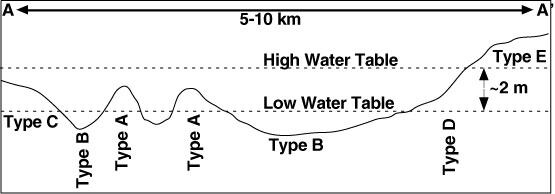

Figure 6. Schematic reconstruction of the Chilga sedimentary basin during Oligocene time. Based on the stratigraphic and lateral relationships of paleosols and sediments, a proposed facies relationship of the different soils is superimposed upon the paleolandscape. The line A-A’ marks the lower cross section of the soil landscape. Type A paleosols (Protosols) are associated with sediments indicative of environments characterized by frequent sedimentation, such as stream levees and crevasse splay deposits. Type B paleosols (Histosols) form in local to regional depressions characterized by ponded water or very slow runoff in ever-wet environments, such as swales adjacent to stream levees. Type C paleosols (Gleysols) form in fine-grained sediments characterized by poorly drained and waterlogged environments across the floodplains and interfluves that underwent long periods of anoxia and aquic soil moisture conditions. However, development of soil structure and redoximorphic coloration in the upper horizons of Type C paleosols indicates some periods of better drainage, possibly during periodic fall of the regional groundwater table. Type D paleosols (Vertisols) form in clay-rich sediments characterized by periodic cycles of wetting and drying, possibly related to seasonal fluctuations of the regional water table. Type E paleosols (Argillisols) formed upon the most stable portions of the landscape, likely in paleogeographic positions most distal from depositional centers (i.e., streams) and topographically well above the position of the groundwater table. See text.

